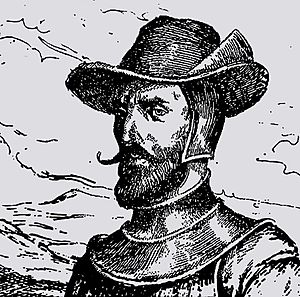Ambrosius Ehinger facts for kids
Quick facts for kids
Ambrosius Dalfinger
|
|
|---|---|

Portrait of Ambrosius Dalfinger
|
|
| Born | ~1500 Ulm, Free Imperial City of Ulm
|
| Died | February 1533 |
| Cause of death | Poisoned arrow |
| Nationality | German |
| Other names | Ambrosio Alfinger |
| Occupation | Conquistador |
| Years active | 1529->1533 |
| Employer | Welser family of Augsburg Spanish Crown |
| Known for | Founding of Maracaibo European Exploration of Northern South America |
Ambrosius Ehinger (also known as Ambrosio Alfínger in Spanish) was a German explorer and leader. He was born around 1500 near Ulm, Germany. He died in May 1533 in what is now Colombia. Ehinger was the first governor of a German colony in northern South America. This area is now part of Venezuela. It was known as “Little Venice” (Klein-Venedig).
Contents
A New Start in South America
Ambrosius Ehinger worked for the Welser family. They were a powerful banking family from Germany. The Welsers planned to start a colony in South America. They chose Ehinger to be its first governor.
Arriving in the New World
In 1529, Ehinger arrived in Coro. He came with 281 other settlers. They called their new home “Little Venice.” Ehinger quickly made Nicolaus Federmann his main helper.
Founding Maracaibo
In August 1529, Ehinger led his first trip. He explored the area around Lake Maracaibo. The native people, called the Coquivacoa, fought hard against them. After several tough battles, Ehinger founded a settlement. This happened on September 8, 1529.
He first named the city Neu Nürnberg (New Nuremberg). He named the lake after a brave native leader, cacique Mara. Mara had died fighting. Later, when the Spanish took over, the city was renamed Maracaibo.
A Break and a New Journey
Ehinger became sick with malaria. He decided to go to Hispaniola to get better. He left his helper, Federmann, in charge. This was on July 30, 1530.
When Ehinger returned, he started another big trip. On September 1, 1531, he left Coro. He had 40 horsemen, 130 foot soldiers, and many native allies. They were looking for gold in the west.
Challenges on the Expedition
Their journey was very difficult. They crossed mountains and rivers. They faced strong resistance from native tribes. Many of their native allies died from the cold in the mountains. The group even had to eat their horses and dogs to survive.
The Final Battle
As they headed back home, they were attacked. This happened on May 27, 1533. The Chitareros attacked them. Ehinger and another captain tried to escape. They hid in a small valley.
But the Chitareros shot arrows at them. Ehinger was hit in the neck by a poisoned arrow. He died a few days later, on May 31, 1533. He was buried under a tree. The rest of his group returned to Coro without him.
Ambrosius Dalfinger's Legacy
Many years later, in 2021, Maracaibo celebrated its 492nd anniversary. As part of this, Ambrosius Dalfinger's remains were moved. They were brought from Colombia to Maracaibo, Venezuela. He was reburied in the El Cuadrado Luxburg-Carolath Cemetery. This event was called "OUR DECEASED LIVE-AMBROCIO ALFINGER." It was a joint effort by the Catholic Church in Colombia and a German foundation.
A special church service was held. It honored all those who died during the time of exploration and colonization. This was a step towards peace between native peoples and Europeans. After the service, Dalfinger's remains were taken to their new resting place.
See also
 In Spanish: Ambrosio Alfinger para niños
In Spanish: Ambrosio Alfinger para niños

